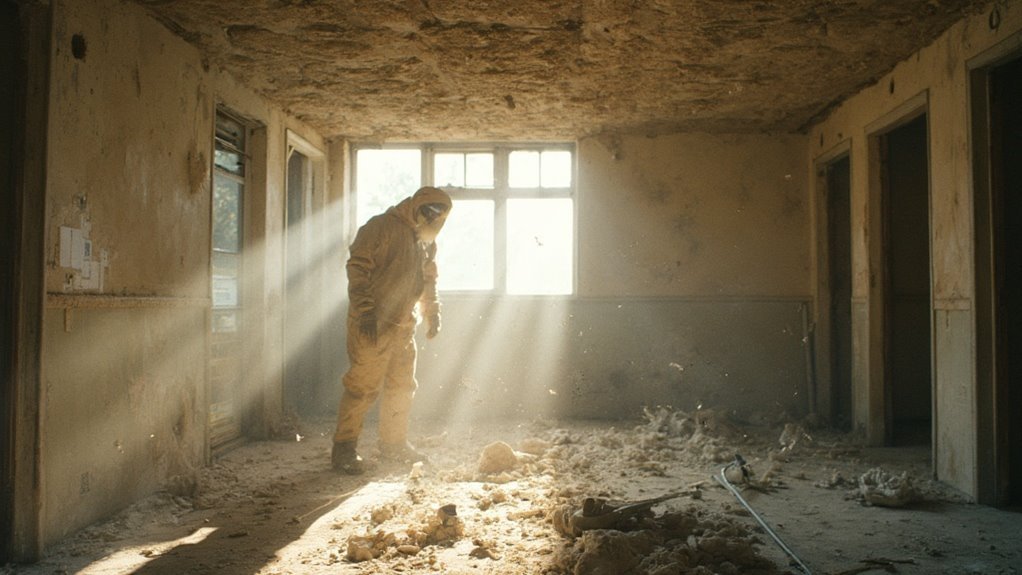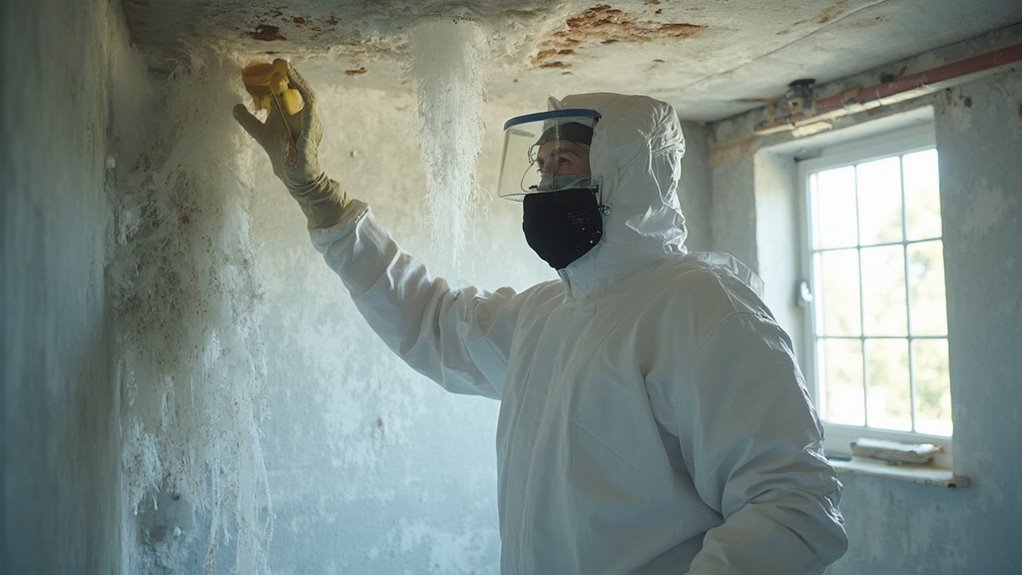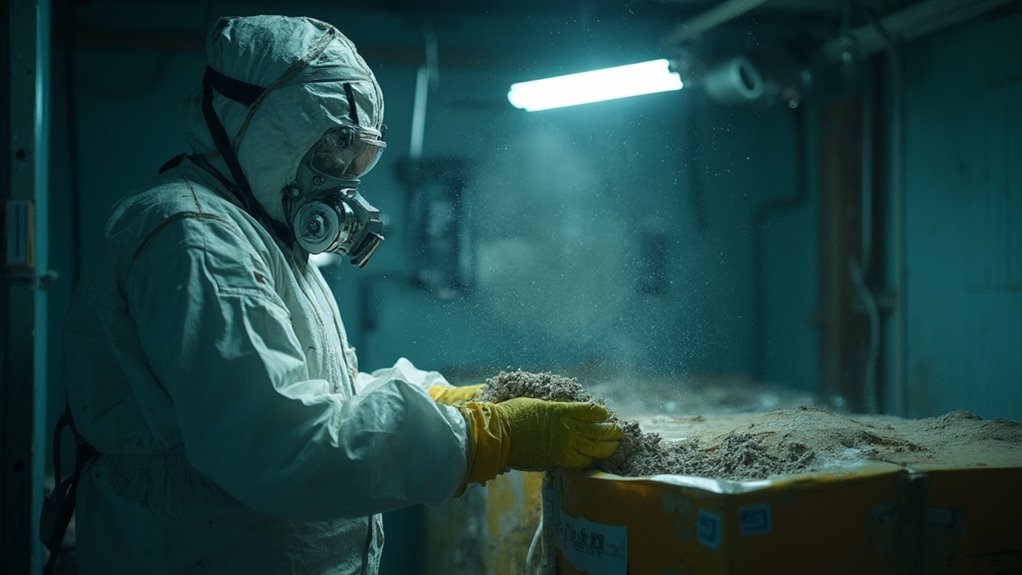Asbestos removal is essential for your health as it eliminates exposure to this dangerous material linked to severe diseases like lung cancer and mesothelioma. When asbestos-containing materials are disturbed, fibers can enter the air you breathe, posing serious long-term risks. By safely removing asbestos, you minimize the likelihood of respiratory issues and allow for regular health monitoring. Professional handling guarantees proper disposal and prevents cross-contamination, safeguarding both your living environment and its value. Understanding the complexities of asbestos abatement can further improve your safety measures and awareness of risks involved.
Health Risks of Asbestos Exposure

When it comes to asbestos exposure, understanding the health risks is fundamental for anyone who may come into contact with this hazardous material. Asbestos exposure links to severe diseases, including lung cancer and mesothelioma, which are often fatal. You should be aware that the cancer risk markedly increases, especially for those who smoke. The combination of asbestos and tobacco exposure creates a "far greater-than-additive" risk for lung cancer.
Asbestos symptoms can be vague initially, manifesting as coughing or shortness of breath, which often leads to delayed medical attention. Unfortunately, these diseases typically take years to develop, with symptoms arising 15 to 50 years after initial exposure. Conditions like asbestosis, characterized by scarring of lung tissue, can impair lung function and lead to disability or death. Long-term exposure to asbestos can also lead to significant health risks, including an increased likelihood of developing serious respiratory diseases, such as lung cancer and digestive system cancers.
If you suspect you've been exposed, recognizing the long latency period is vital for seeking timely medical care. Regular check-ups and awareness of your exposure history are fundamental for early detection. Understanding these risks empowers you to take proactive steps for your health and safety.
Recognizing Asbestos-Containing Materials
To effectively recognize asbestos-containing materials, you need to be aware of common sources like floor tiles, ceiling tiles, and insulation. Visual identification can be tricky, as these materials often resemble non-asbestos counterparts, making professional testing crucial for confirmation. Additionally, legal requirements necessitate that certified inspectors conduct thorough testing to ensure the safety and compliance of your environment. By understanding these factors, you can better assess the risks associated with asbestos in your environment.
Common Asbestos Sources
Identifying common sources of asbestos in your environment is crucial for protecting your health and that of others. Many people still hold onto asbestos myths that downplay the dangers of this material, often because of its historical usage in construction. Understanding where you might find asbestos can help mitigate risks.
| Common Locations | Types of Products |
|---|---|
| Ceilings | Acoustical plaster, textured paints |
| Walls and Insulation | Cement-asbestos boards, vermiculite |
| Flooring | Vinyl tiles, adhesive backing |
| Roofing and Exterior | Shingles, chimney flue linings |
High-risk areas include attic insulation and older flooring materials, which often contained asbestos. Moreover, roofing materials in vintage homes can pose a threat, especially when weathered. Fireproofing materials in buildings constructed before the 1980s may likewise harbor asbestos. Awareness of these sources empowers you to seek professional testing before undertaking renovations or demolitions. By staying informed, you can protect not only your health but as well that of your loved ones.
Visual Identification Challenges
Maneuvering the visual identification of asbestos-containing materials (ACMs) can be particularly challenging due to the myriad of colors and appearances that asbestos can assume. Asbestos fibers can present in various colors—blue, brown, or white—making color alone an unreliable indicator. Often, these fibers are mixed with other materials, which can obscure their true nature. For instance, vermiculite insulation appears pebble-like and may contain asbestos, while asbestos pipe insulation can resemble common cardboard.
Visual inspection difficulties arise as individual asbestos fibers are too small to see with the naked eye, and they often blend seamlessly into the surrounding materials. You might find asbestos in materials that closely mimic standard construction products, such as smooth grey asbestos cement.
To improve your accuracy in identifying ACMs, fiber identification techniques are necessary, as they allow for a more detailed examination. Nevertheless, visual inspection alone is insufficient; professional testing remains vital for accurate identification. Remember, disturbing these materials can release harmful fibers into the air, emphasizing the importance of caution and professional assistance in managing potential asbestos exposure.
Importance of Testing
Visual identification of asbestos-containing materials (ACMs) can lead to significant oversights, making professional testing vital for accurate recognition. Understanding the significance of testing goes beyond mere identification—it's a legal requirement under various asbestos regulations. Following proper testing procedures guarantees that you're not exposing yourself or others to harmful asbestos fibers during renovation or demolition activities.
- Federal and state regulations mandate asbestos surveys before construction projects.
- Professional assessments utilize methods like Polarized Light Microscopy (PLM) for accurate identification.
- Bulk sampling and laboratory analysis are important steps in detecting ACMs.
- Compliance with OSHA and EPA guidelines is fundamental for safety.
- Pre-renovation testing minimizes health risks associated with asbestos exposure.
Importance of Asbestos Abatement

The significance of asbestos abatement cannot be overstated when it comes to safeguarding health. Asbestos exposure is linked to serious diseases like asbestosis, mesothelioma, and lung cancer. These conditions often develop silently over years, making early detection difficult and underscoring the need for immediate action.
Proper abatement techniques are vital to minimize these health risks. A thorough risk assessment helps determine when abatement is necessary, taking into account the condition of asbestos-containing materials and the potential for disturbance. In some cases, encapsulation may be sufficient, while complete removal is often required for damaged materials in high-traffic areas.
Adhering to asbestos regulations is critical for legal compliance and public safety. Certified professionals must carry out abatement projects following EPA and OSHA guidelines to guarantee safe practices. By eliminating asbestos sources, you not only protect health but additionally improve property value, providing peace of mind for occupants and enhancing marketability.
Preventive Measures for Safety
Regular health check-ups are essential for early detection of any asbestos-related issues, so don't overlook them. Implementing safe cleaning practices, especially after asbestos removal, helps minimize exposure to any residual fibers. By prioritizing these preventive measures, you greatly improve your overall safety and well-being.
Regular Health Check-ups
Over time, individuals exposed to asbestos need to prioritize regular health check-ups to monitor their lung health and catch any early signs of related diseases. These health evaluations are fundamental since asbestos-related illnesses can develop decades after exposure.
Consider the following aspects of regular check-ups:
- Asbestos screening: Important for detecting any lung damage early.
- Chest X-rays: Help identify signs of asbestos fibers in the lungs.
- Pulmonary function tests: Assess lung capacity and pinpoint breathing difficulties.
- Physical examinations: Significant for recognizing symptoms of asbestos-related diseases.
- Detailed medical histories: Required for accurate diagnosis and tailored treatment plans.
Safe Cleaning Practices
Guaranteeing safety during asbestos removal requires meticulous cleaning practices that prevent the spread of hazardous fibers. During the post-removal phase, effective decontamination is imperative. You'll want to confirm the entire area is thoroughly cleaned using wet mops, wet rags, sponges, or HEPA vacuum cleaners. This approach effectively captures and contains any remaining asbestos particles.
Establishing clean zones and dirty zones helps minimize cross-contamination. After working with asbestos-containing materials (ACMs), you must shower and change into clean clothing to remove any residual fibers. Furthermore, it's crucial to use proper personal protective equipment (PPE) like respirators and coveralls throughout the process.
Regular air quality monitoring is significant, as it allows you to assess the effectiveness of your cleaning efforts. Specialized air filtration units should be employed to capture and filter out dangerous fibers, enhancing overall safety.
Lastly, sealing off work areas with plastic sheeting and using clear signage helps inform others of potential hazards, further promoting a safe environment. By adhering to these safe cleaning practices, you not only protect yourself but also contribute to the well-being of others in the vicinity.
Professional Handling and Disposal

When handling asbestos, professionals must adhere to strict protocols to guarantee safety and compliance. Utilizing professional techniques guarantees that the risks associated with asbestos exposure are minimized effectively. Here are key practices involved in managing asbestos safely:
- Sealing the Work Area: This prevents contamination from spreading.
- Use of Wet Methods: These techniques reduce fibre release during removal.
- Proper PPE: Workers wear full protective gear to safeguard against exposure.
- Sealing Waste: Asbestos waste is sealed in heavy-duty plastic bags to contain hazards.
- Licensed Disposal: Waste is transported and disposed of at licensed landfill sites.
Disposal protocols are just as critical. Asbestos waste must be double-bagged and properly labeled, guaranteeing that it's recognized as hazardous material. Licensed carriers are responsible for transporting the waste, maintaining documentation throughout the process. This thorough approach not only protects the health of workers but similarly the surrounding community. By following these guidelines, you can guarantee that the handling and disposal of asbestos are conducted safely and legally, greatly reducing health risks associated with this dangerous material.
Environmental Impact of Abatement
How does asbestos abatement influence the environment? Proper asbestos abatement is essential for preventing environmental contamination and ensuring ecosystem preservation. By adhering to environmental regulations, you can greatly reduce the risks associated with asbestos disposal. Here's a breakdown of the impacts:
| Contamination Type | Impact |
|---|---|
| Soil Contamination | Asbestos fibers can leach into the soil, harming local flora and fauna. |
| Water Pollution | Fibers may contaminate water sources, affecting drinking water and aquatic life. |
| Air Pollution | Improper handling leads to airborne fibers, degrading air quality in surrounding areas. |
| Long-Term Damage | Asbestos fibers persist in the environment, posing ongoing hazards. |
Safe disposal methods prevent these issues, protecting both the environment and community health. For instance, sealing off work areas and using negative air pressure systems can effectively manage airborne pollution. By following OSHA and EPA guidelines, you not only comply with legal requirements but additionally contribute to sustainable practices. Remember, your efforts in asbestos abatement play an essential role in preserving ecosystems and promoting a healthier planet for future generations.
Long-Term Health Monitoring
Recognizing the critical importance of long-term health monitoring, especially for those involved in asbestos-related work, is crucial for safeguarding worker health. Exposure to asbestos can lead to severe long-term effects, making it necessary to remain vigilant even after removal efforts are complete.
Here's what you should know about health monitoring:
- Initial assessments are necessary before starting any asbestos work.
- Baseline testing focuses on respiratory health and establishes a starting point.
- Regular check-ups help in early detection of health changes.
- Monitoring frequency is typically determined through risk assessments, often occurring every two years.
- Post-exposure monitoring guarantees continued health safety after significant exposure incidents.
Maintaining Property Value and Safety
Asbestos poses a dual threat to property owners, impacting both the safety of occupants and the overall value of the property. The presence of asbestos can greatly lower property valuation, often by 5-15% compared to asbestos-free homes. Potential buyers perceive asbestos as a serious health risk and financial burden, leading to reduced offers or demands for price reductions. This market perception can diminish your property's appeal, as buyers may shy away from homes with known asbestos issues.
Removing asbestos can improve your property's value by eliminating these concerns and restoring buyer confidence. By investing in professional abatement, you not only comply with legal obligations to disclose asbestos but can additionally boost your negotiating position. Properties that have undergone safe asbestos removal often enjoy a market advantage, attracting higher offers than comparable homes without abatement.
Moreover, the costs associated with asbestos removal usually fall on the homeowner, further impacting property value if not addressed proactively. By prioritizing asbestos removal, you protect your investment, guarantee safety, and maintain the long-term value of your property in an increasingly health-conscious market.
Frequently Asked Questions
How Can I Identify if My Home Has Asbestos?
Did you know that about 30 million homes in the U.S. may contain asbestos? To identify asbestos materials, use reliable asbestos testing methods and inspect areas like insulation, flooring, and ceilings for signs of this hazardous substance.
What Are the Costs Associated With Asbestos Removal?
Asbestos removal costs vary considerably based on area size and type. You'll need asbestos testing to determine presence, and professional removal services typically range from $1,192 to $3,240, depending on specific circumstances and location.
Can I Remove Asbestos Myself?
Think twice before tackling DIY asbestos removal. The DIY asbestos risks are significant; without safe removal techniques and proper training, you could endanger your health and face legal liabilities. It's best to hire certified professionals.
How Long Does the Asbestos Removal Process Take?
The asbestos timeline varies based on the removal duration, influenced by factors like area size, condition, and accessibility. Small projects might take days, while larger ones can extend to weeks or months for thorough abatement.
What Should I Do if I Suspect Asbestos Exposure?
Nearly 15,000 individuals die annually from asbestos-related diseases. If you suspect asbestos exposure, monitor for symptoms like persistent cough or chest tightness, and consult a healthcare professional to evaluate potential health risks and recommend necessary tests.
